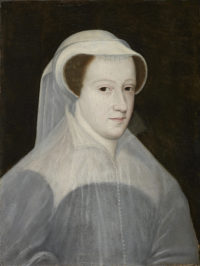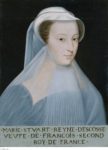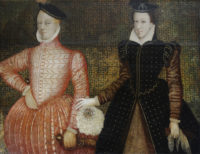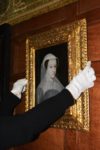 An extremely rare portrait of Mary, Queen of Scots, painted during her lifetime has gone on display at Hever Castle. The oil-on-oak panel painting depicts Mary “en deuil blanc” (in white mourning), wearing gossamer white veils instead of the heavy blacks of full mourning she wore in a later portrait.
An extremely rare portrait of Mary, Queen of Scots, painted during her lifetime has gone on display at Hever Castle. The oil-on-oak panel painting depicts Mary “en deuil blanc” (in white mourning), wearing gossamer white veils instead of the heavy blacks of full mourning she wore in a later portrait.
It is believed to have been the work of the studio of François Clouet, a miniaturist and portraitist to the French royal family, made in late 1560/early 1561 when Mary was mourning the successive deaths of her father-in-law King Henry II of France (d. July 1559), her mother Mary of Guise (June 1560) and her husband Francis II (December 1560) of France. White had been a popular mourning color in France for centuries by the time Mary donned it. She had unusually bucked that association and worn white for her 1558 wedding to the then-Dauphin of France, only to find herself having to wear white again in its traditional symbolism after his death just two and a half years later.
 Another Clouet portrait of her “en deuil blanc” shows her covered from chin to chest in a white pleated gauze “barbe” (beard). The original painting is lost but the image was widely copied. The Hever painting has the same head type as the other Clouet but depicts a less severe white veil with an open collar and tiny buttons down the bust. This may have been a less strict form of mourning worn after a certain amount of time had elapsed from the bereavement.
Another Clouet portrait of her “en deuil blanc” shows her covered from chin to chest in a white pleated gauze “barbe” (beard). The original painting is lost but the image was widely copied. The Hever painting has the same head type as the other Clouet but depicts a less severe white veil with an open collar and tiny buttons down the bust. This may have been a less strict form of mourning worn after a certain amount of time had elapsed from the bereavement.
During her active reign in Scotland from 1561 to 1568, there were few artists of note and even  fewer portrait painters of royal quality. If any solo portraits of her were painted during her time in Scotland, none have survived. A double-portrait of her and her second husband Lord Darnley now at Hardwick Hall in Derbyshire, is the only known extant portrait of Mary, Queen of Scots, painted when she was in Scotland ruling as Queen of Scots, ca. 1565.
fewer portrait painters of royal quality. If any solo portraits of her were painted during her time in Scotland, none have survived. A double-portrait of her and her second husband Lord Darnley now at Hardwick Hall in Derbyshire, is the only known extant portrait of Mary, Queen of Scots, painted when she was in Scotland ruling as Queen of Scots, ca. 1565.
After her forced abdication and imprisonment in England, she did get some access to court painters. Her caretaker/keeper/jailer George Talbot, 6th Earl of Shrewsbury, allowed her to sit for Nicholas Hilliard, the premiere miniature portraitist of the Tudor court. Copies of Hilliard’s work were distributed at Mary’s behest to her supporters during her lifetime, and after the ascension of her son James VI of Scotland to the throne of England and Ireland in 1603. He commissioned idealized versions of them to enhance his own position as king and the strength of the Stuart claim by depicting her as a martyr and  victim of Tudor injustice. It’s those posthumous images of Mary that make up the bulk of her portraiture.
victim of Tudor injustice. It’s those posthumous images of Mary that make up the bulk of her portraiture.
The Hever portrait was in a private collection in France (not Switzerland) for many years. It was thought to be a modified 17th century copy of the more famous Clouet. Dendrochronological analysis of the oak panels found that the wood dated to 1547. Coupled with stylistic examination, the age of the wood confirms that the portrait dated to the mid-16th century and was done in Mary’s lifetime.
Dendrochronology is very cool. I understand that the dendrochronologists at Williamsburg, VA date the timbers in their buildings by back-figuring using the widths of the annual-rings, starting with trees living in the present.
Mention of this restarted my irritation over the recent film about Mary. The film makes out that she had a Scottish accent: don’t these people do ANY research?